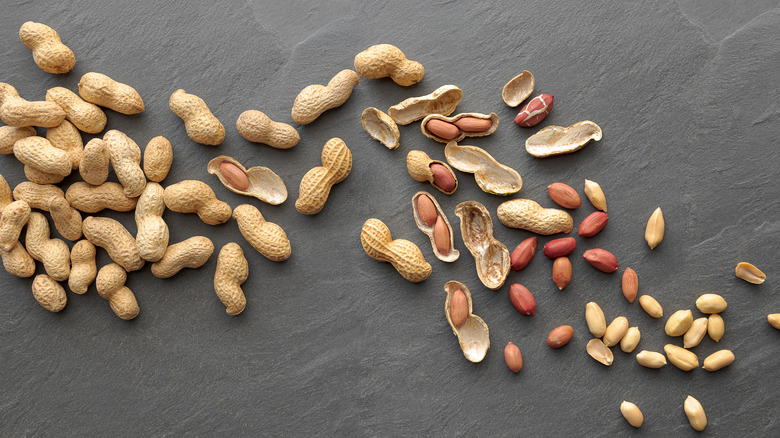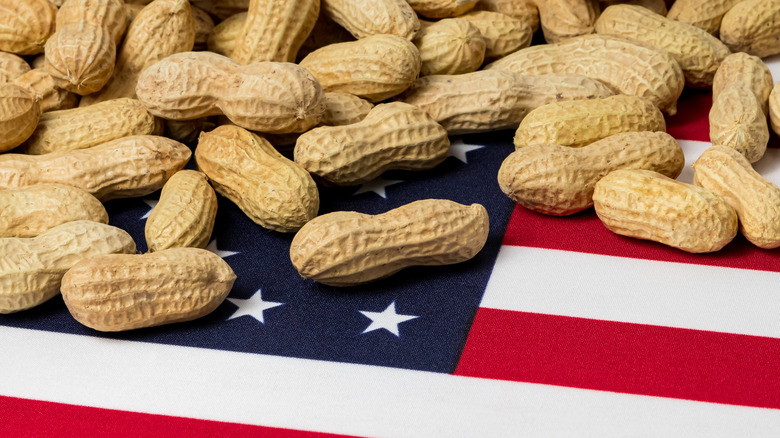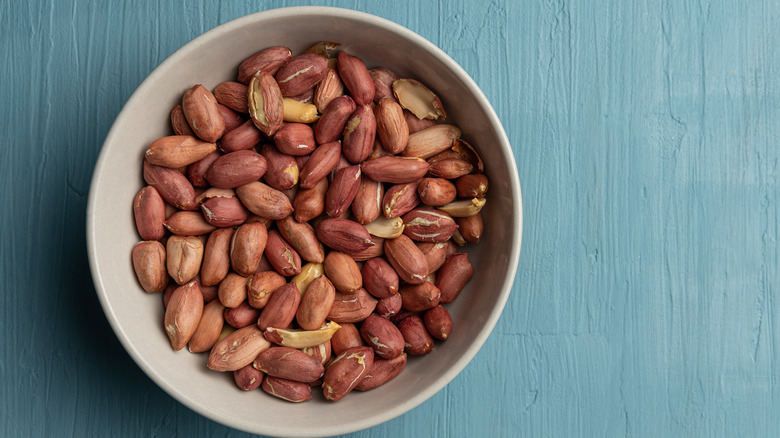These Are The 4 Varieties Of Peanuts
When you think of nuts, an image of a peanut might come to mind. Well, we hate to burst your bubble, but peanuts actually aren't considered nuts at all. According to WebMD, peanuts are a part of the legume family, sharing similar DNA and protein structures to peas, soybeans, and lentils. It's because of their natural, nutty taste and crunchy texture — as well the fact that they have "-nuts" in their name — that makes people think peanuts are nuts.
Having first started their sprouts on American soil in the 1800s, peanuts have become an important source of protein, fat, and fiber for a lot of people. An estimated 6.4 billion pounds of peanuts were produced in the United States in 2021 (per Statista), amounting to an estimated six pounds of peanuts consumed per U.S. citizen every year (per WebMD).
While the image of a large, shelled peanut might come to mind, that's only one variety of peanut. There are, in fact, four different varieties of peanuts that are grown (and eaten) in different ways.
Runner and Virginia
You may think a peanut is just a peanut, but that couldn't be further from the truth. According to Peanuts USA, there are four different types of peanuts: Runner, Virginia, Spanish, and Valencia. All four peanut types hold various flavors and sizes, too — no peanut is the same.
Runner peanuts are the most popular and dominant type of peanut cultivated in the United States — mostly throughout Georgia, Alabama, Florida, Texas, and Oklahoma — making up more than 80% of the U.S. peanut supply, according to the National Peanut Board. These are most often used in making peanut butter and candies because the kernels are usually the same size, making them easy to work with in large-scale manufacturing.
Virginia peanuts on the other hand, are the cream of the crop. Because they boast the biggest kernels, Virginia peanuts are the big and perfect-looking shelled peanuts that might first come to mind when you think of peanuts. These are best for cracking open and snacking, offering peanut lovers the prettiest and biggest nut shells to dive into. As their name implies, these are mostly grown and cultivated in Virginia and the Carolinas (per the National Peanut Board). Unlike Runner peanuts, these only amount to a mere 10% of all U.S. production (via Peanuts USA).
Spanish and Valencia
One of the smallest peanut varieties, Spanish peanuts only make up 2% of all U.S. peanut production, according to Peanuts USA. They're easy to recognize, with their reddish-brown skins around the kernels and their overall nutty flavor.
Spanish peanuts have a higher oil concentration than their three sisters, making them ideal for peanut oil and use in candy bars and in snacking. They're only grown in the Southwest, including Texas, New Mexico, and Oklahoma.
Last but not least, Valencia peanuts are easiest to spot because they grow three or more kernels per shell. These are the sweetest among all varieties, so they are best used in all-natural peanut butter to avoid needing to add sugar or artificial sweeteners. They are also best enjoyed boiled without needing any salt or seasoning. These sweet peanuts only amount to less than 1% of all U.S. peanut production, being mainly sourced in New Mexico (per Peanuts USA).


